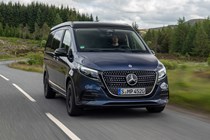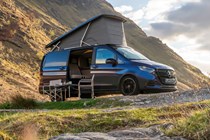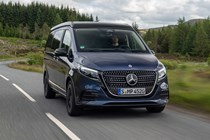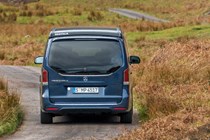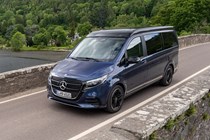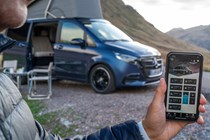
Mercedes-Benz V-Class Marco Polo interior, tech and comfort
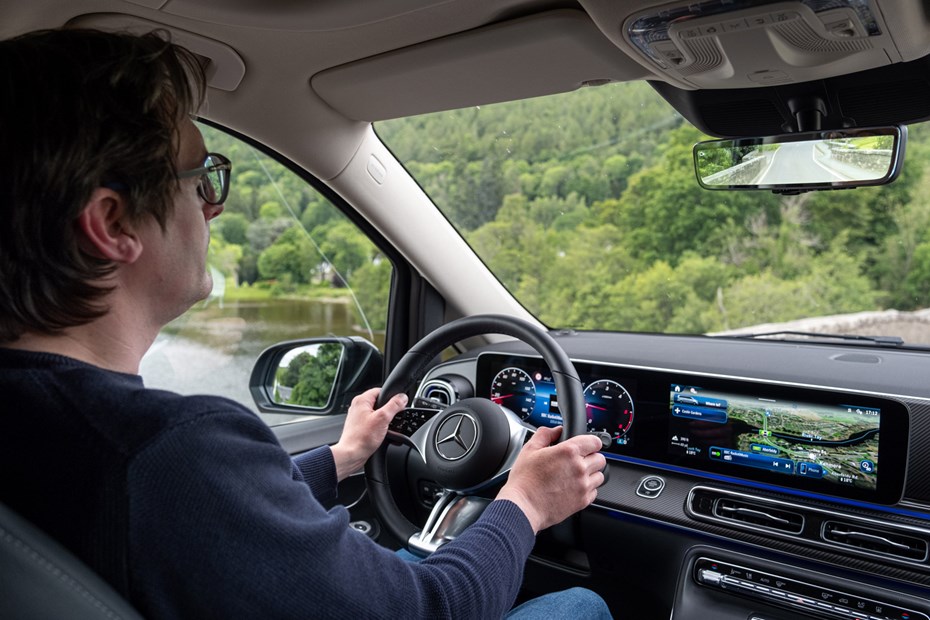
- Updated cab meets modern Mercedes’ standards
- Living space is very high quality
- Clever camping features now fully integrated
How is the quality and layout?
One of the major updates for the latest version of the V-Class Marco Polo is the new dashboard layout, which brings it into line with the rest of the Mercedes passenger car range. It now boasts a very modern-looking dual-screen set-up, with a 12.3-inch digital instrument cluster placed alongside a 12.3-inch central touchscreen to give a continuous widescreen effect.
While this and the build quality throughout is hard to fault – as already mentioned, the fit and finish in the back of this camper is at a level beyond even the VW California, and bears very little resemblance to a commercial vehicle – there are some quirks arising from the Marco Polo’s van-based origins. When driving you sit very high, which meant that it felt like we were almost on top of the steering wheel.
Even though the wheel adjusts for reach and tilt angle, this does result in a flatter steering position, rather like a bus. We didn’t have a huge problem with this, ergonomically, but it is a noticeable difference from driving a regular car – even a big one such as one of the best SUVs – and you have to glance a long way down from the road to read the instruments.

Moving on to the camping arrangements, both front seats swivel to face the rear of the van, creating a lounge-like space opposite the rear bench, which itself slides back and forth as well as offering individual backrest adjustment that ultimately allows you to lay flat and the bench to transform into part of the lower bed. A table slides out between the bench and the kitchen units and props up with reassuring stability between the two sets of chairs on a single folding leg.
The rear cabin floor is finished in what Mercedes calls ‘Land Yacht’, another nice detail and seemingly hardwearing, too. The kitchen area comprises a sink, twin gas hob and 40-litre cool box along the top, with drawers and cupboards below. Behind this is a small wardrobe area with illuminated vanity mirror, while right at the back of the van is the gas-bottle storage and an external shower fitting. This is probably best for hosing off the dog, but is there if needed by bolder campers.
The pop-up roof is electrically operated, but the interior ceiling is a manual affair involving a couple of slightly awkward clips. It’s also rather heavy – we found it easy enough to move around, but if you’re a smaller solo camper make sure you test this out in the showroom. Similarly, access to the roof sleeping area involves climbing up via the front seats. It’s difficult to do this elegantly. The Transit Custom Nugget‘s rear access via ladder may suit the less nimble, though the California’s layout is the same as the Marco Polo.
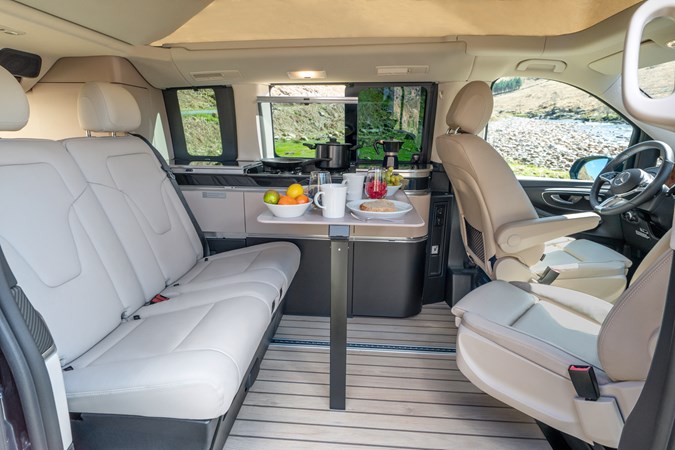
The top bed is the comfier one, with plastic coil springs and a thin but supportive memory foam mattress. At 5’11” and around 82kg we had no trouble getting a good night’s rest, but if you’re much taller it might start feeling a little cramped up there. A topper for the lower bed is intended to help overcome the compromises involved in sleeping on even horizontal seats, but we’d still choose the top deck first.
There are neat lighting solutions and plenty of power sockets throughout, as well as blinds built into most of the window areas. The only exceptions are the windscreen – where the cover is held in place by the sun visors – and the magnetic covers for the front side windows. We found the blind for the tailgate window very tricky to hook up, but all the others worked perfectly.
Infotainment and tech
Mercedes has now integrated the camping controls into the MBUX infotainment system, which is a big improvement over the slightly aftermarket-feeling add-on controller that we’ve previously criticised. This is all fairly intuitive, although activating the optional self-levelling air suspension when parked does require a little prior knowledge of the system.
It’s also a little odd that you can’t see the level gauges while it’s working because it involves holding down the parking camera button, which activates the parking camera view screen. Still, there’s a clear message on the instrument cluster when it’s done, and we then checked back to see how level it actually was. We tried a couple of different parking areas, and found it levelled perfectly side-to-side and was never more that one degree out front-to-back.
The van being flat no matter if the ground beneath is bumpy is a real boon for sleeping and this automatic system is a fantastic luxury touch that again elevates the Marco Polo beyond the competition.

Mercedes’ smartphone app can be used to control the camping functions as well – these also include a camping mode that stops you upsetting your campsite neighbours by, amongst other things, preventing all the lights coming on when you activated the remote locking. The MBUX infotainment works very well in general, with excellent voice control and augmented reality navigation in addition to Apple CarPlay and Android Auto.
Comfort
- Front seats fine for all-day driving
- Rear seats are close together
- Quiet inside even at higher speed
Since we’ve dealt with the sleeping comfort above, here we’ll concentrate on our experience of the driving comfort (before covering the suspension comfort on the following page). As a modern camper van with a powerful and economical diesel engine, the Marco Polo appears well intended to travel lengthy distances between camp sites – and we’re happy to report that the front seats should be perfectly suited to this kind of adventuring. There’s plenty of support to keep you comfortable all day.
The oddity about the rear seats is that the two passengers have to sit right next to each other – but since they’ll also likely be sharing a bed that shouldn’t be too difficult deal with. Again, these seats are well-sculpted and supportive, perhaps a shade more so than the VW California’s. They’re also unusually adjustable, due to being able to fully recline into a horizontal sleeping position. We don’t recommend you go that far while being driven, however.
Overall vehicle refinement is pretty good now. The original 2.1-litre diesel engines were a little noisy but the newer 2.0-litre variants are much quieter and smoother – we detected no vibration at all in the cabin and only really heard anything under hard acceleration. It’s not an unpleasant sound, either. There’s also little wind or road roar to speak of, with just the occasional rustle around the roof top and door mirrors.


